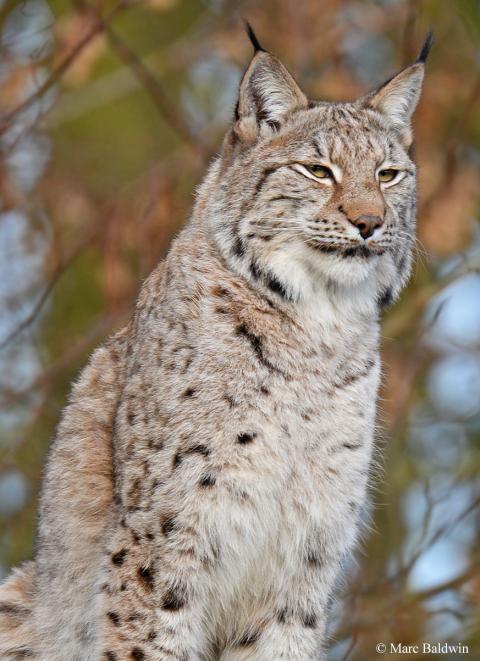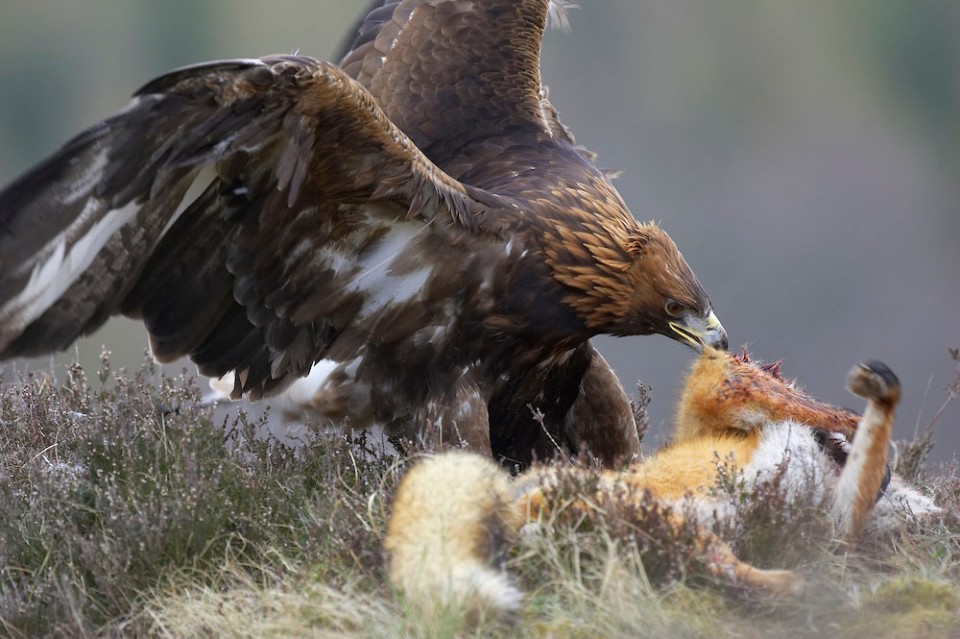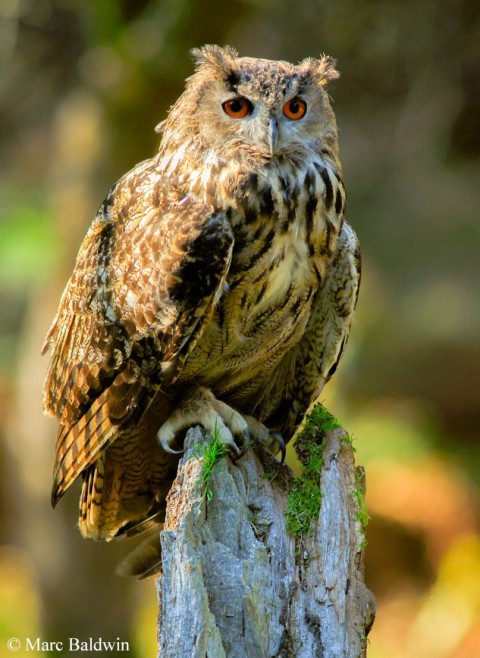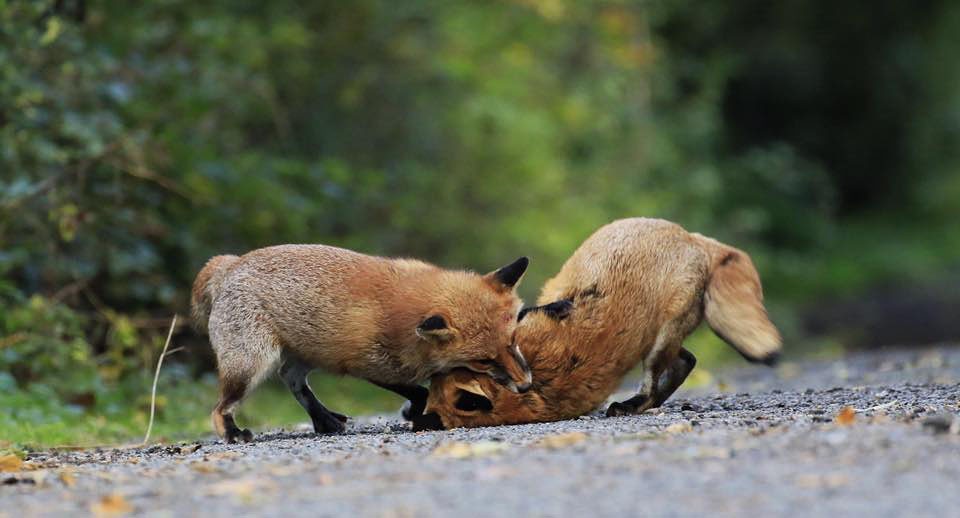Red Fox Predators
The concept of what exactly makes a predator is far from straightforward. Often, a predator is thought of as anything that kills something else, but the zoological definition of a predator is an organism (typically, but not exclusively an animal) that catches, kills and eats another animal; these three components are important. This definition works well for most of the species we typically think of as predators -- lions, tigers, most sharks, crocodiles, birds of prey, wolves, etc. -- and may also include many herbivores (if they find, up-root and eat a plant), although there are some grey areas where things like cookiecutter sharks (Isistius brasiliensis), which catch and feed on prey but don't kill it, fit in, for example. The important point, though, is that a predator hunts other animals (arguably also plants) for food. This is different to competition removal -- one animal killing another while fighting over a mate, or killing another to stop it eating your food, drinking your water, using your space, etc.

The reason I'm labouring the point somewhat is that in most cases where foxes are killed by other large predators (wolves, coyotes, lynx, bears, dingoes, etc.), it is invariably done to remove a potential competitor. Coyotes and foxes, for example, feed on the same types of small mammal prey and so the former frequently kill the latter to remove the competition -- this is referred to as competitive exclusion. The coyotes very rarely eat the foxes they kill (see below); they typically don't see the foxes as prey, they see them as competition to be removed, so they are not technically predators of foxes. The same is true of domestic dogs, wolves, bears, and lynx, which occasionally kill foxes but do not consume the carcass. In her 2014 book, The Carnivore Way, Christina Eisenberg mentions that cougars (Puma concolor) "prey on mesopredators such as foxes", although she doesn't say whether this includes feeding on the carcass or how often it occurs. Overall, it is fair to say that foxes have very few true predators and, more generally, predators rarely eat other predators.
The details of the threats posed to foxes by other large carnivores (wolves, lynx, bears, dingoes and coyotes, all of which can potentially have a significant impact on fox numbers) through competitive exclusion is covered at length in an associated QA. Sufficed to say, foxes can be displaced by these larger carnivores (e.g. wolves, coyotes, bears) and the relationships may be complex. In a paper to the journal Ecology during 2012, for example, Taal Levi and Chris Wilmers at the University of California report how the reintroduction of wolves causes the displacement of coyotes and an increase in fox abundance, which potentially has consequences for local small mammal and bird populations.
Despite such ecological 'cascades', with the possible exception of lynx, none of these are true predators of foxes. A 2007 study published in the Journal of Wildlife Management estimated that 38% of Red foxes in rural areas of the USA died following predation/aggression from coyotes, compared with only 12% living in urban areas. Domestic dogs may also suppress fox populations through both direct attacks (particularly on cubs) and disturbance and it has been suggested both that high numbers of feral and stray dogs in developing countries may explain the apparent lack of foxes there and that recent control of stray dogs in Britain has made life a little easier for urban foxes. There are, however, some animals for whom foxes -- especially cubs -- are very much on the menu.
Eagles & owls - the "superpredators"
In the UK and much of Europe the main non-human predator of the Red fox is the golden eagle (Aquila chrysaetos). In the UK, this magnificent raptor is restricted to the Highlands of Scotland and isolated patches of northern England (e.g. Cumbria), while globally it ranges over most of the Northern Hemisphere, from the southern border of the Arctic Circle south to roughly the Tropic of Cancer. According to the Royal Society for the Protection of Birds, golden eagles can lift a maximum of four or five kilograms (9-11 lbs) -- adult male foxes average around 7 kg (15.5 lbs), while females average 5.5 kg (12 lbs), which might suggest that only young foxes are taken by these raptors. That said, adult eagles may kill adult foxes and feed on the carcass in situ, rather than carrying the carcass away, allowing them to tackle larger animals.
Cubs appear to be the most common victims of eagle predation and, in his 2010 opus The Golden Eagle, the late Jeff Watson noted that it is not unusual to find the remains of fox cubs in eyries (eagle nests), especially in the western Highlands of Scotland. Similarly, in her 2001 book The Blood is Wild, Bridget MacCaskill noted how, upon climbing to an eyrie in the Scottish Highlands, she and her husband found:
"At the back of the nest, where ledge met sheer cliff, lay two crumpled bundles of red fur. Two small brushes, both with a white tip, were still attached."
Watson gives values of canids (mainly Red foxes, although domestic dogs are apparently occasionally taken) in the diet of UK eagles ranging from 0.6% in the eastern Highlands of Scotland to 4.3% in the south-west Highlands and describes how the birds use a "low flight with slow descent attack" (one of seven attack strategies) to hunt carnivores. This strategy involves hovering motionless over prey and, when the prey turns its head away, the eagle swoops down, lands on the back of the neck and "rides" the quarry until it collapses; the prey is held by the eagle until it's dead. Some interesting footage of a fox and eagle meeting at a red deer carcass in the Scottish Highlands during January 2016 was captured by the BBC's Winterwatch team.

The footage, filmed by a remote camera in the Trossachs National Park in the Cairngorms, shows an adult fox chasing a female eagle off the carcass before displaying and lunging at her mate who appeared shortly afterwards. One fight was captured, during which the eagle gasped the fox's muzzle with its talons and pulls it, the result is that the fox ends up on top of the eagle, pinning it down and after a short altercation the eagle flies off. Footage from after the fight shows the fox feeding at the carcass and the female eagle coming back in. The eagle startles the fox and it retreats a couple of feet away before coming back in and displaying aggressively (tail curled down, head down, ears flat and mouth agape) at the bird, which gave way and the fox moved past, body arched and broadside to the eagle, and continued feeding as the bird watched for a second or two and then flew away. A fascinating example of how foxes may not always come off the loser when they meet golden eagles.
Studies elsewhere on Golden eagle diets have revealed similar data to those given by Watson -- that foxes are not an uncommon dietary component, but generally don't represent a significant part of the diet. During a five year study of eagle diet in Sweden, Martin Tjernberg found Red fox remains in 47 (1.6%) of the 2881 items recovered from 162 eyries. Splitting these data out, Tjernberg found that foxes accounted for less than 1% of the diet of eagles living in mountainous regions, 1.5% of those living on mountain slopes and almost 2% of those living in coniferous forests. Of these fox remains, the vast majority (83%) were cubs. A study on golden eagle diet in the central-eastern Italian Alps between 1984 and 1989 found that foxes contributed 4% of the diet while, in a 2001 paper to the journal Ardea, a team of French biologists presented figures showing the abundance of canids (again, presumably largely Red fox, although the authors don&'t specify) in the diet of eagles in the Mediterranean Basin; dietary occurrence ranged from 0.7% in the southern Alps to just over 13% in Sicily.
Why, though, should there be such variation in the contribution of foxes in the diet of eagles? The answer, it seems, may lie in the availability of the eagles' preferred food. In a fascinating literature review of superpredation (where one predator kills and eats another) in four large European birds of prey (goshawk, golden eagle, Bonelli's eagle, and the European eagle owl), a team of Mediterranean biologists argue that the food stress hypothesis explains why these birds take carnivores.

Essentially, the authors suggest that when the eagle's preferred prey (e.g. deer, rabbits, hares, game birds, etc.) is in short supply, they are forced to broaden their diet to include prey they wouldn't normally bother with; predators are, after all, more difficult to find (they exist in lower numbers) and more dangerous to catch than their normal prey animals. The fact that cubs tend to appear on eyries (when adults have hungry chicks to feed) seems to support this theory. This literature review reports that all the papers they found on Golden eagle diets had some mention of fox, but they made up only just over 2% of the combined diets; foxes were found among prey remains of the Bonelli's eagle (Aquila fasciata) and eagle owl (Bubo bubo - left), but made up less than 0.5% of the diet of each.
So, overall Red foxes don't seem to be a significant food source for Golden eagles, but there are examples where these birds have caused considerable declines in other fox populations. The situation is quite different for the second smallest fox species -- the critically endangered Island fox (Urocyon littoralis) -- on the California Channel Islands. It seems that a major decline in the population of feral pigs caused the eagles on the islands of Santa Cruz, San Miguel and Santa Rosa to switch their diet to focus more heavily on the islands' foxes, causing a catastrophic (95%) decline in the populations -- such was the concern that the Island Fox Conservation Working Group (IFCWG) was established in 1999 to address the issue.
The IFCWG set about catching as many of the foxes as they could and holding them in captivity while they began re-locating the eagles away from the islands. In a paper to the Proceedings of the Sixth California Islands Symposium, Brian Latta and his colleagues report that removal of 70% of the known eagles from Santa Cruz and Santa Rosa resulted in fox survival rates on the former island rising to near pre-decline levels. Tracking of the eagles suggests that, once re-located to north-eastern California, the birds survive and don't come back to the islands; translocation thus appears to be a viable alternative to lethal control. How this scheme will pan out in the future, with new birds migrating in as the regional population grows, remains to be seen.
The only other bird of prey in Britain capable of taking foxes is the European eagle owl (Bubo bubo). It is widely cited that eagle owls will take foxes, both adults and cubs, although there is a scarcity of data to show how significant they are as a predator. In the aforementioned literature review of raptor superpredation, fox remains were identified in just under half the dietary studies of eagle owls, accounting for only 0.3% of the total diet. There are some reports to suggest that foxes may not be favoured prey, being 'picked at' by the owls, rather than consumed greedily. One such account is of an owl that was found to have cached a fox cub, which it consumed over several days. In his 1983 Owls of Europe, Hemio Mikkola described how, one evening, a female eagle owl was seen to:
"... remove an entire fox cub from beneath a neighbouring plant Smilax, having concealed the cub the day before or that same morning. The fox was not completely eaten that night and its remains were hidden again in the same place at the end of the meal. The next day, the operation was repeated."
Occasional predators
Other occasional predators of Red foxes include long-tailed weasels (Mustela frenata), ermine (Mustela erminea), skunks (Mephitis mephitis), mink (Mustela vison) and snakes, all of which may take young fox cubs. In North America, as in Europe, owls (Strigiformes) and hawks (Accipitriformes) take older cubs and occasionally adults. Even smaller birds will sometimes attack foxes, although it seems unlikely that they see them as prey. There was a fascinating account in a 1964 issue of British Birds describing an apparently unprovoked attack by a tawny owl (Strix aluco) on a Red fox drinking from a pond in the owl's territory one day in January. It's unclear why the owl launched the attack; it seems very unlikely the fox posed it any threat and it is too early in the year to be protecting a nest (although there is a reliable report of a tawny owl chick in mid-January in south Wales).

Arguably humans can also be considered a predator. Fox meat can be purchased at some butchers in the UK and, in at least one location in Asia, humans have teamed up with golden eagles to hunt foxes for meat and skins. This fascinating partnership was recently filmed by the BBC for inclusion in their Human Planet series. The wide-open terrain of the Altai Mountains in Western Mongolia makes hunting almost impossible and this has led the Kazakh people, who have inhabited these mountains for some 200 years, to form a unique relationship with the resident golden eagles.
The hunters capture a chick from the nest and train it (for about five months) to hunt; they then head out on horseback, carrying the eagle, to hunt Mongolian Red foxes (Vulpes vulpes beringiana) on the snowy tundra. The hunters take the eagle to high ground, from where it may observe fox movement on the tundra below and take off in pursuit. The fox clearly recognises the eagle as a predator and runs for its life; at some point during the chase, however, the fox turns and faces down the eagle, growling and gekkering. It seems that if the eagle does not hit the fox directly (landing instead on the ground next to the fox), the prey escapes. If, however, the eagle can land on the fox, the bird's job appears to be to pin the fox down until the hunter arrives to dispatch the prey -- it's not clear how proficient the eagles would be at killing these adult foxes themselves. The eagle is then given the fox's lungs in reward while the meat and fur is used by the tribe. Not all eagles, it seems, can be trained to hunt foxes.
While not technically predators, foxes have been intentionally killed by deer, typically when perceived as a threat to their young. The great writer and naturalist H. Mortimer Batten, in a comment on a statement by eminent Highland ecologist Frank Fraser Darling that foxes regularly killed red deer (Cervus elaphus) calves, described how a group of red deer hinds (females) surrounded a fox hiding in a clump of bracken, walked slowly inwards and "trampled that fox into a jelly". Foxes, especially their cubs, may occasionally fall foul of European badgers (Meles meles) too.
As with deer, badgers typically aren't true predators of foxes (for the same reason that wolves, coyotes, etc. aren't), although they may have a significant impact on their population, and some of the data from the Randomised Badger Culling Trial in England suggest that reducing badger numbers can lead to an increase in foxes through competitive release (remove your competitor and there's more room for you to thrive). This finding warrants further study, but it certainly seems plausible that reducing badger numbers provides plenty of free setts (which foxes will also use) and frees up food that the two species normally compete for (e.g. earthworms, rabbits, fruit, etc.). While the precise impacts require further study, we do know that aggression is at least one mechanism by which badgers displace foxes.
In North Wales during 1958, Abel James witnessed a stand-off between a vixen and a badger on a cliff edge. Mr James noted that the fox and badger were snarling at each other when the vixen, finding herself trapped, tried to leap over her opponent. Unfortunately for the vixen, the badger reared up and seized her leg and the two proceeded to roll around the cliff top locked in combat. The pair rolled towards, and then over, the cliff edge - by the time Mr James made it down the cliff, both were dead. Mr James' account is not unique and, in their book Badgers, Ernest Neal and Chris Cheeseman describe several instances of badgers and foxes embroiled in fierce combat. Similarly, in his 1923 book, The Badger Afield and Underground, Batten provides several examples of badgers killing fox cubs.

Perhaps the most interesting account, however, comes from E. Clay in a communication to The Countryman. Mr Clay described hearing screams coming from a dense blackberry bush while watching fox cubs play on a hillside near his home in Devon. Upon moving closer, he discovered one of the fox cubs lying there with one of its back feet bitten off, its hind quarters apparently paralysed and skin torn on its shoulders. Mr Clay then saw the head and forequarters of a large badger appear; it gripped the cub by the throat and dragged it down a nearby hole. This account is interesting because it bears considerable resemblance to a feeding-motivated attack, rather than a defensive strike. Obviously Mr Clay was unable to follow the badger down the hole and it remains unknown whether the fox cub was consumed. It should be noted that incidences of badgers killing foxes (and indeed, foxes killing badgers) are far from commonplace, and where the two species occur together they are usually very tolerant of each other, although it is the badger that is invariably dominant.
Martens are another group of mustelids that appear to be occasional predators of fox cubs, although the extent of this activity remains largely unknown. Nonetheless, there are at least two very interesting video clips of which I'm aware, both from France, showing a marten (either a pine Martes martes or stone marten Martes foina) entering a fox earth and bringing the cubs above ground before killing them. In late March 2021, Cyril Treveys captured one such event during which a marten killed and took away at least two cubs, while the second was filmed by Marlene Piraud in the Lorraine region during mid-April 2022 and showed a marten removing one or two cubs from an earth. I'm not aware of any records of martens attacking adult foxes.
Fox vs. fox
Finally, foxes may be predated by other foxes. The subject of infanticide (the killing of young) in Red foxes, the carcasses of which are occasionally eaten, is covered in an associated Q/A, and there is plenty of evidence that adult foxes will sometimes kill other adults. There is also evidence to suggest that foxes will scavenge fox carcasses if they happen upon them (I know of no reports to suggest they deliberately kill and eat other adult foxes). Indeed, in a 2010 paper to the journal Contemporary Problems of Ecology, Russian researchers noted that, under adverse conditions, foxes engage in cannibalism. One of the report's authors, Tatiana Kiener at the Moscow State University, told me of the following incident at the Sikhote-Alin Nature Reserve in the Russian Far East during March 2008:
"A red fox corpse (male) was found near a waterstream in snow. It was about 1 week old. We observed some old traces - a kind of struggle in snow. There were also the tracks of the other fox (male) on the snow. The other fox visited the corpse several (5-6) times. All meat was devoured. There were no tracks of other animals nearby. We suppose it could happen under deficit of food in this season."

Urban foxes are occasionally found with fox remains in their stomachs (see: Food and Feeding); these are presumably scavenged from road-kill, but imply that cannibalism may not be restricted to very harsh environments.